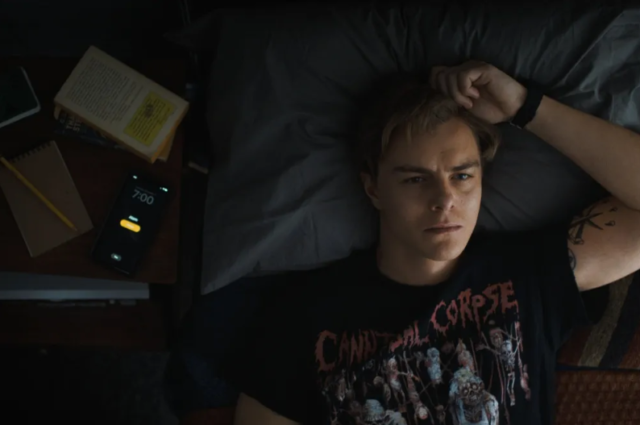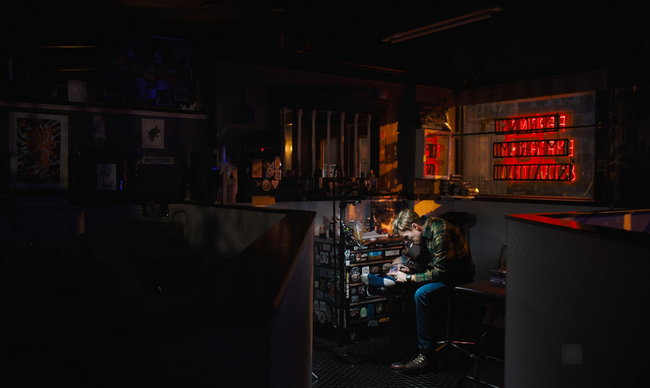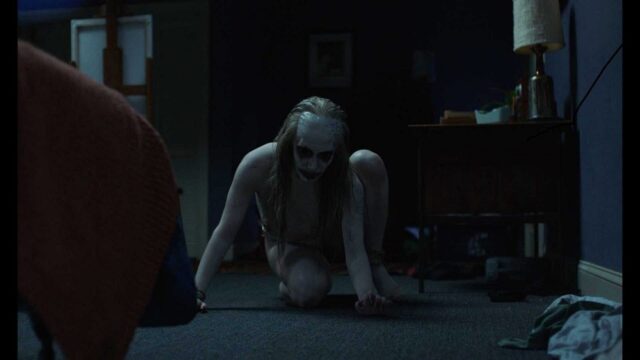Nighttime. A man and a young boy, presumably father and son, drive out to a cemetery shrouded with tall dense trees. Keeping the boy at a distance, the father goes to a particular concrete headstone, dousing it in gasoline. He then ignites the gasoline and the headstone bursts into lames. As it burns ever brighter and higher, the man pulls out a gun and shoots himself, dropping to the ground as the boy’s terror-filled face covers the screen. As the boy watches in horror, we see multiple figures appearing almost raven-like in appearance, covered and hooded in black from head to toe with no face visible, surrounding the fiery headstone and corpse; Harpies sent from the Underworld to take the man with them. As the fire crackles against the inky blue-back darkness of night, one of the figures starts to approach the boy, scuffling and filled with the very essence of malevolence.
And with that, writer/director Tyler Chipman wastes no time in drawing us into the darkness of THE SHADE. As visually stunning as it is shocking, the beauty and horror of the film’s opening serve as two sides of a coin, setting the stage for difficult themes of mental illness, suicide, abandonment, grief, and more.

Fast forward a year and we meet 20-year-old college student Ryan. Since his father’s suicide, home life has been a struggle. His mother Renee constantly works as if avoiding memories of being in the house with her now-deceased husband. With mom somewhat disengaged from the family and the responsibilities that go with it as a mother and head of household, it falls to Ryan to look after his younger brother James and get him up, fed, dressed, off to school, homework done, etc., and all while attending to his own college classes, working as a pizza delivery guy, apprenticing at a tattoo parlor, trying to give his girlfriend Alex attention, and making his appointments with therapist Dr. Huston. As if keeping all the balls in the air isn’t difficult enough, another layer of stress comes with the re-appearance of his older brother Jason who left home and dropped out of school with nary an explanation. And now he’s back and not in a loving or caring way towards Ryan or their mother. Jason does, however, seem to have time and care for James. But with the return of Jason, a family secret also returns.
For the next approximate hour of the film, either you are (1) going to be extremely patient with observational character constructs of a family drama until we get into the third act where the action picks up, revelations are made, secrets exposed, and some wonderful horror and supernatural-esque visuals take shape, or, (2) you are going to turn off the film from tedium. It will be your choice.

Diving into an examination of suicide and its collateral damage, grief, and mental illness, Chipman does his best to provide an exponential amount of character context and natural dialogue in order to create empathy and understanding, but waits a bit too long for any “reveals” or visual support that provides a basis for the level of emotional darkness we are seeing within the Beckman family.

Watching the family dynamics, we see Jason’s alcohol-fueled substance abuse and antagonism with accompanying mood swings. Ryan, although meeting regularly with Dr. Huston, struggles to remember to take his medication (a plethora of pill bottles are in the medicine cabinet) as if he doesn’t want to admit he has a problem. He also battles with his girlfriend Alex who knows something is “off” and wants to help him, but he’s afraid to let her in. And James is the one observing everything that’s happening. He has perhaps the clearest vision of what’s happened and happening to his family.

Performances by Chris Galust as Ryan, Dylan McTee, and Sam Duncan as James are strong and resonant. You see and feel the sibling connection among the characters. For my money, as strong as Galust is as Ryan with brooding frustration steadily rising, a standout is Sam Duncan as youngest brother James who plays James as just an everyday kid; but one who is very observant. Michael Boatman fills the bills nicely as the sympathetic therapist Dr. Huston.
Notable is that during that initial hour following the shocking opening events, we not only meet the Beckman brothers and mother, but we engage with the town and the people in it. There is a wonderful small-town feel that is only enhanced by the Massachusetts location and beautiful lighting and lensing of cinematographer Tom Fitzgerald.
Stunning are night scenes that welcome the inky blue-black of the night and yet are filled with the orange glow of fires, be it raging on a headstone or during a fun college bonfire night in the woods. The film overall has a darker visual tonal bandwidth thanks to the increasingly moody and somber lighting which gives great contrast when needed, as well as some well-placed framing that intensifies the effect of slow pushing-in of the camera and use of closets and doors that celebrate the use of negative space. Using Panavision’s Pvintage lenses, Fitzgerald gives us a look with beautiful fall-off and a softer, almost “dreamy” feel that complements the film’s themes addressing the darkness of mental illness, what’s real and not real. Not to harp on it, but the film’s opening sequence is an attention-getting visual shocker, made more so by the textures captured in the lensing. Overall, there is a welcoming natural look to the film.

Hand in hand with Fitzgerald’s work is that of production designer Carl Sprague. From the Beckman home to the local pizza parlor to classrooms, this looks and feels like “Anytown, U.S.A.” and one in which you could lead a quiet and peaceful life; another aspect that adds to the story as the Beckman life is anything but quiet and peaceful.
While I can see what Chipman is trying to do as a writer and director in telling this story and giving time to the film’s themes, editing needed to be sharper with the film trimmed by an easy ten minutes in order to keep the audience completely engaged. Pacing, while consistent, is a bit too slow during that first hour and runs the risk of boredom.

Not to give away spoilers, but the visual highlight of THE SHADE comes in the form of supernatural and demonic elements by way of chilling hair and specialty makeup paired with visual effects affecting the movement of one of these demonic elements. (Trust me when I tell you this “demon” has all the hallmarks of becoming a legendary Halloween horror costume.) And as mentioned earlier, sadly, it takes about an hour before Chipman tickles our fancies with that. But rest assured that once these visual elements kick in, the hairs on the back of your neck will stand up and your blood pressure will rise as fear and terror build. What are these elements? Are they real? From where, or from whom, did they come? Is Ryan imagining things? Is he descending into madness? Or is everything real?

Completing the aesthetic of THE SHADE is Brian McOmber’s score which adds to the increasing undercurrent of fear and foreboding while not overshadowing the film’s core themes.
Making his feature narrative directorial debut with THE SHADE, with strong suits being the cinematography, specialty make-up and score, Tyler Chipman has shown himself to be a capable director. But in the future, he may want to narrow the scope of his vision and be more expeditious in getting to the heart of the matter.
Written and Directed by Tyler Chipman
Cast: Chris Galust, Dylan McTee, Sam Benson, Laura Benanti, Michael Boatman, Mariel Molino
by debbie elias, 10/18/2024












